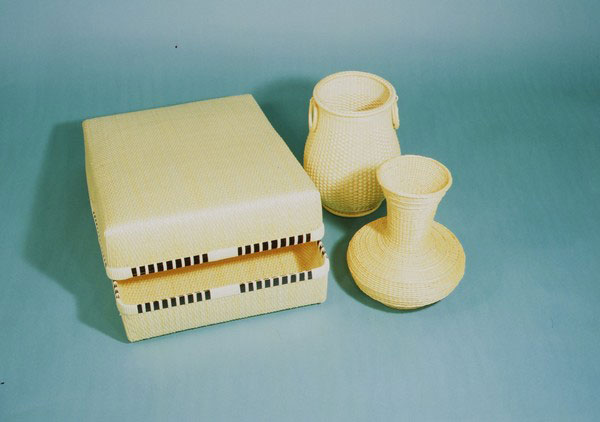
- Wood, bamboo crafts
- Hyogo
Toyooka wicker crafts Toyooka kiryu zaiku
Strong but supple willow tree
Fusion of traditional skills and modern designs
Description
What is Toyooka wicker crafts ?
Toyooka Wicker Crafts, called Toyooka Kiryu Zaiku in Japanese, is wickerwork produced around Toyooka City, Hyogo Prefecture. The origins of the craft are found in the baskets woven from Salix koriyanagi, a species of willow naturally growing in the area around the Maruyama River, and when Toyooka was a thriving castle town, basket weaving was established as a local industry. Their characteristic features are natural textures and the durability of strong and supple willow. Every piece is hand-woven by artisans, and overflowing with warmth. They are practical traditional crafts quietly blending into our daily modern life. There are various weaving techniques: six different types of basic weaving, 33 types of in-fill weaving, and 18 different styles of finishing for the basket rims. By combining them, an extensive range of shapes can be created. The main traditional articles are deep round baskets, and square containers with lids used as a lunch box. Recently, Kiryu Zaiku handbags designed in modern styles are also gaining popularity.
History
Toyooka Kiryu Zaiku can be traced back to the beginning of the 1st century. It is said that in AD 27, the prince of Silla (currently Korea), Ame no Hiboko no Mikoto, introduced wickerwork to Japan. Historians consider that the craft had started from weaving everyday items including baskets by using willows naturally growing in the area along the Maruyama River, and the techniques were established around the 9th century. A Toyooka Kiryu Zaiku titled “Tajima no Kunisan Yanagibako” is among the articles held in the Shoso-in Treasure House of Todaiji Temple. Later, in the Edo period (1603-1868), Lord Takamori KYOGOKU promoted cultivation of willow and basketry techniques as well as the distribution of the products and developed the craft as a local industry, which resulted in Toyooka Kiryu Zaiku being known throughout the country. In the Meiji period (1868-1912), production of Western style handbags started, and in the Taisho period (1912-1926), hand baskets with a lock came into vogue, and they were called "Taisho Baskets". Around 1965, Crown Prince Naruhito attending Gakushuin Kindergarten regularly used a small basket which was known as the "Naru-chan Bag", and it became immensely popular. Today, the industry has also broadly launched into general merchandise and interior fields.
Production Process
- 1. Weaving the bottom The production work starts from weaving the bottom section. Willow rods to be used as uprights called tateri are laid flat, and fine willow called amiso are flat-woven through them to create the bottom of the basket.
- 2. Weaving the lid Next, the lid section is woven. Adjustments are made at this stage, so that the lid is larger than the tateri of the woven bottom section. Finer and particularly beautiful willow are used for weaving the lid.
- 3. Securing the bottom and inserting tateri A wooden model in the shape of the basket is placed on top of the woven bottom, and the basket sides are prepared. Marks are made around the perimeter of the bottom weave at regular intervals and holes are opened to insert the tateri, ready for basic weaving. Support cores are added to supply strength and rigidity.
- 4. In-fill weaving After weaving up to the desired height, the wooden model is removed and the rim is finished off. A technique called ogamibuchi is used to adjust and make sure that the lid fits tightly. Finally, the last two tateri are woven, and any excess parts are trimmed.
- 5. Finishing the lid The lid is woven in the same way as the bottom.
- 6. Making the handles The handles to be attached to the lid are made by winding willow around round-shaped wisteria cores.
- 7. Attaching the handles and lid Finally the handles and lid are attached to complete the basket.
Facility Information
Tajima Chiiki Jibasangyo Shinko Center
-
Address
-
Tel.+81-796-24-5551
-
ClosedDecember 30 to January 2
-
Business Hours9am to 5pm
-
Website
Other Wood, bamboo crafts
- Hakone wood mosaic
- Iwayado traditional chest
- Kaba cherrybark woodcrafts
- Odate bentwood
- Inami wood carvings
- Matsumoto furniture
- Beppu bamboo crafts
- Edo wood joinery
- Ichii woodcarvings
- Suruga bamboo crafts
- Edo bamboo fishing rods
- Kishu bamboo fishing rods
- Kamo traditional chest
- Kyo wood joinery
- Miyakonojo archery bows
- Osaka carved wooden panel
- Miyajima woodwork
- Nibutani carved wooden tray
- Okuaizu Basketry
- Echizen traditional chest
- Kasukabe traditional paulownia chest
- Katsuyama bamboo crafts
- Osaka karaki wood joinery
- Takayama tea whisks
- Toyooka wicker crafts
- Akita cedar tubs and barrels
- Nagiso woodturning
- Kishu traditional chest
- Nagoya traditional paulownia chest
- Osaka bamboo screens
- Osaka-senshu traditional paulownia chest
- Sendai traditional chest

































































































































































































































































































